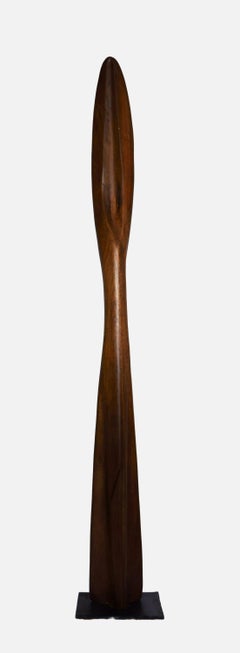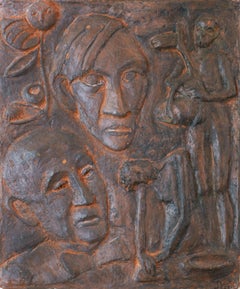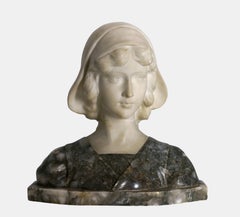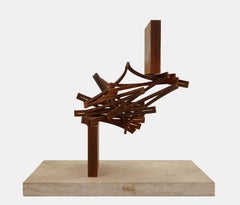Want more images or videos?
Request additional images or videos from the seller
1 of 11
Paul DierkesArchaic Head / - Shaped Originality -1952
1952
Price:$2,082.26
About the Item

About the Seller
5.0
Vetted Professional Seller
Every seller passes strict standards for authenticity and reliability
Established in 2014
1stDibs seller since 2023
22 sales on 1stDibs
Authenticity Guarantee
In the unlikely event there’s an issue with an item’s authenticity, contact us within 1 year for a full refund. DetailsMoney-Back Guarantee
If your item is not as described, is damaged in transit, or does not arrive, contact us within 7 days for a full refund. Details24-Hour Cancellation
You have a 24-hour grace period in which to reconsider your purchase, with no questions asked.Vetted Professional Sellers
Our world-class sellers must adhere to strict standards for service and quality, maintaining the integrity of our listings.Price-Match Guarantee
If you find that a seller listed the same item for a lower price elsewhere, we’ll match it.Trusted Global Delivery
Our best-in-class carrier network provides specialized shipping options worldwide, including custom delivery.You May Also Like
Tête de faune, Picasso, Tile, Ceramic, Sculpture, Design, Postwar, Mythological
By Pablo Picasso
Located in Geneva, CH
Tête de faune, Picasso, Tile,Ceramic,Sculpture, Design, Postwar, Mythological
Tête de faune
Unique work
circa 1968
Painted and partially glazed ceramic, square tile
15.2 x 15.2 cm
C...
Category
1960s Post-War Figurative Sculptures
Materials
Earthenware
$97,014
H 5.99 in W 5.99 in D 0.6 in
Visage, Picasso, 1950's, Unique work, sculpture, design, Frame, Portrait
By Pablo Picasso
Located in Geneva, CH
Visage, Picasso, 1950's, Unique work, sculpture, design, Frame, Portrait
Visage
Unique work
1957
Painted and partially glazed ceramic ; tomette
16.9 x 15.2 cm
Certificate of authent...
Category
1950s Post-War Figurative Sculptures
Materials
Ceramic
$88,732
H 6.66 in W 5.99 in D 0.79 in
Petit masque central, Pablo Picasso, 1960's, Unique, Design, Plate, Theater
By Pablo Picasso
Located in Geneva, CH
Petit masque central, Pablo Picasso, 1960's, Unique, Design, Plate, Theater
Petit masque central
Unique work
16.5.63
Painted and partially glazed ceramic
D. 25.4 cm / 9.8 in.
D. 33 ...
Category
1960s Post-War Abstract Sculptures
Materials
Ceramic, Earthenware
$72,169
H 10.01 in Dm 10.01 in
Mother & Child
Located in Knowle Lane, Cranleigh
The sculpture titled "Mother & Child" by Bettina Seitz beautifully captures the intimate bond between a caregiver and an infant through its elegant form. Crafted from a unique white ...
Category
2010s Contemporary Figurative Sculptures
Materials
Stone
ITALIAN MARBLE FIGURE OF A GRIFFIN, 19th Century
Located in Milan, IT
ITALIAN MARBLE FIGURE OF A GRIFFIN
Italy, early 19th Century
marble
87 x 54 x 20 cm
34 1/4 x 21 1/4 x 7 3/4 in
Category
19th Century Abstract Sculptures
Materials
Marble
$41,408
H 34.26 in W 21.26 in D 7.88 in
A lady. Contemporary bronze sculpture, Abstract & figurative, Polish art
By Stanisław Wysocki
Located in Warsaw, PL
Contemporary bronze sculpture on marble base by Polish artist Stan Wysocki. Artwork comes from limited edition of 8. Sculpture depicts female figure filtered through geometric, synth...
Category
2010s Contemporary Abstract Sculptures
Materials
Marble, Bronze
$5,915
H 23.23 in W 6.7 in D 4.73 in
Claude-Levy Cast Iron Sculpture of Flora, Dated 1925
Located in New York, NY
Claude-Lévy, 1895 – 1942
Alice Nikitina in the role of Flora, from the Dukelsky/Braque production of the ballet Zephyr & Flore at the Ballets Russes, 1925
Cast Stone
Signed and dated: Claude-Levy 1925 on rear face of self-base.
The present sculpture is as rare as it is delightful. Mademoiselle Claude-Levy, as the
catalogues of the period list her, was one of the truly original talents of the Art Deco period. Painter, architect, decorator, and sculptor, she was a friend of the Parisian, Modernist sculptors, Chana Orloff, Henri Laurens and the Martel brothers, to whom her work was often compared. The ingenuity of her models brought her great critical acclaim, but she seems to have stopped producing in the early 1930s. Her output, although fine, is rare. Claude-Levy’s gentle Cubism might be better described as Purism in sculpture. It is characterized by simplified surfaces, rounded (as opposed to angular) forms, and smooth, lustrous surfaces. The Purist movement included the painters Léger, Ozenfant and Le Corbusier in its ranks.
Claude-Lévy, along with other artists of the avant- garde living in the Gallic capital (Czaky, Zadkine, Archipenko, Lipchitz, Lambert Rucki Miklos, Nadelman, Vörös, Orloff) helped to develop a collective twentieth century figurative sculptural idiom that exploited the daring and rich possibilities of geometric abstraction.
The present work is Claude-Lévy’s Commedia dell’Arte figures inspired by the Stravinsky/Picasso Ballet...
Category
1920s Abstract Sculptures
Materials
Cast Stone
$125,000
H 20.87 in W 11.03 in D 7.88 in
Two-sided bronze sculpture titled "Niño-Niña (Boy-Girl)"
Located in San Francisco, CA
Gabriel Mendoza
Niño-Niña (Boy-Girl), 2020
Bronze on marble base
15.50 x 11.30 x 5.20 in
Edition XII of XII
Sculpture can be shown on two sides: front side is a girl and back side i...
Category
21st Century and Contemporary Arte Povera Figurative Sculptures
Materials
Marble, Bronze
$2,800
H 15.5 in W 11.3 in D 5.2 in
"Night at the Opera" Psychedelic Sculpture White Carves Stone Mouth Singing Fun
Located in Austin, TX
Abstract sculpture titled "Night at the Opera" by Bob Ragan
24 x 12 x 12
Texas Limestone
240
Category
21st Century and Contemporary Abstract Sculptures
Materials
Limestone
$8,500
H 24 in W 12 in D 12 in
Bellowing Bull, White Carrara Marble Stone Figurative Sculpture
By Lutfi Romhein
Located in Clermont-Ferrand, Auvergne-Rhône-Alpes
This sculpture depicts a bellowing bull, full of strength and muscular power.
This artwork was made in direct cuts, then the bull's hair were finished using a smal power tool. It is not polished.
The separated base is made of black veined marble.
A graduate from the Academy of Fine Arts of Carrare, in Italy, Lutfi Romhein...
Category
Early 2000s Modern Figurative Sculptures
Materials
Marble
$3,549
H 13.39 in W 13.78 in D 5.52 in
More From This Seller
View AllVegetative Form / - Grown Art -
Located in Berlin, DE
Paul Dierkes (1907 Cloppenburg - 1968 Berlin), Vegetative Form. Mahogany, 1958. 142 x 16 x 10 cm (sculpture), 21 x 17.5 cm (base), monogrammed "PD" on the reverse.
- Grown Art -
...
Category
1950s Post-War Abstract Sculptures
Materials
Mahogany
$3,312 Sale Price
20% Off
Homage à Kahnweiler / - The Appearance of Genius-
Located in Berlin, DE
Irmgard Biernath (1905 Waldheim in Saxony - 1998 Mainz), Hommage à Kahnweiler, 1984. Terracotta relief, burnished red body, 43.5 x 38 cm, mounted on support plate, in wooden frame 57 x 49.5 cm, monogrammed "IB" at lower right.
- Isolated patina losses, but overall good condition, frame slightly bumped.
- The Appearance of Genius-
This homage to Daniel-Henry Kahnweiler shows the gallerist and art theorist as Pablo Picasso portrayed him in his lithographic portrait of 1957.
As an innovative Parisian gallery owner, Kahnweiler had exclusively represented Picasso since 1911, while Picasso had painted his famous portrait of Kahnweiler the previous year as a major work of Cubism. And it is Picasso who appears at the centre of Irmgard Biernath's image. Here, his face echoes the features of the self-portrait he painted in 1907 in the Prague National Gallery.
His eyes are wide open as he gazes into the distance, surrounded by the works of his artistic vision that have already taken shape. On the right is the bronze "Man with Sheep...
Category
1980s Contemporary Figurative Sculptures
Materials
Terracotta
$1,135 Sale Price
20% Off
Bust of a young woman / - Beauty of youth -
Located in Berlin, DE
Anonymous, Bust of a young woman, c. 1900, artificial marble and gray onyx marble. 37 cm (height) x 37 cm (width) x 22 cm (depth), weight 17.2 kg. Signed “GURRINI” on the reverse.
-...
Category
Early 1900s Realist Figurative Sculptures
Materials
Marble
$899 Sale Price
20% Off
Gradual Rotation / - Dynamic Tectonics -
Located in Berlin, DE
Thomas Röthel (*1969 Ansbach), Gradual Rotation, around 2005. Steel with rust patina mounted on stone plate. Overall dimensions: 38 cm (height) x 34 cm (width) x 27 cm (depth), weigh...
Category
Early 2000s Abstract Abstract Sculptures
Materials
Steel
The Feeding / - Natural grace -
Located in Berlin, DE
Erich Schmidt-Kestner (1877 Berlin - 1941 Nordhausen), The Feeding, around 1915. Gold and black patinated bronze with cast brown patinated plinth mounted on a lightly veined black-gr...
Category
1910s Art Nouveau Nude Sculptures
Materials
Bronze
$4,259 Sale Price
20% Off
Soaring Eagle / - With eagle eyes -
Located in Berlin, DE
Anonymous, Soaring Eagle, mid-20th century Patinated cast metal mounted on quartz block. 24 cm (total height) x 29 cm (width) x 12 cm (depth).
- Patina heavily rubbed in places, screw connections between sculpture and stone...
Category
Mid-20th Century Realist Figurative Sculptures
Materials
Metal



